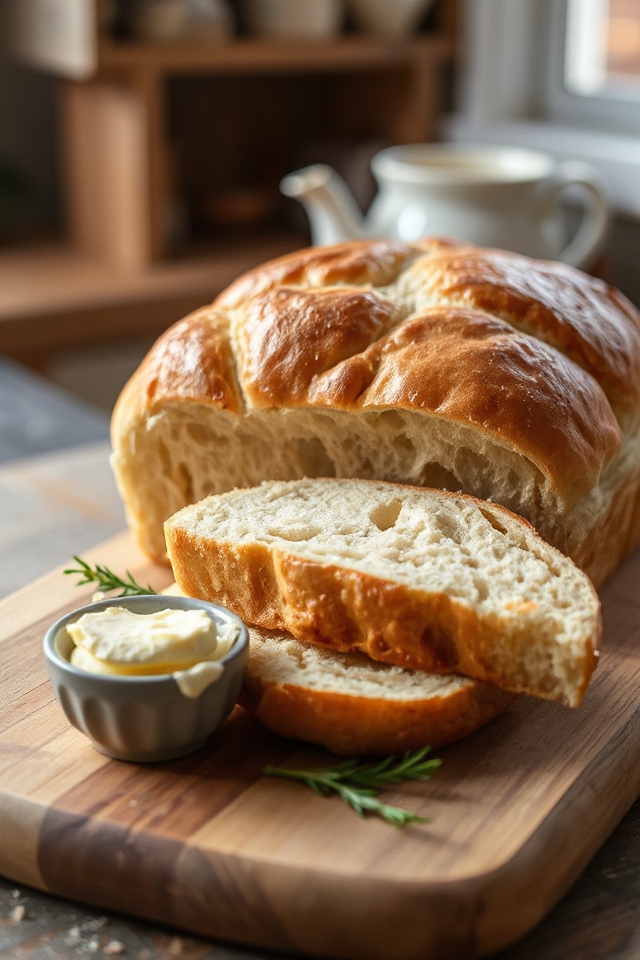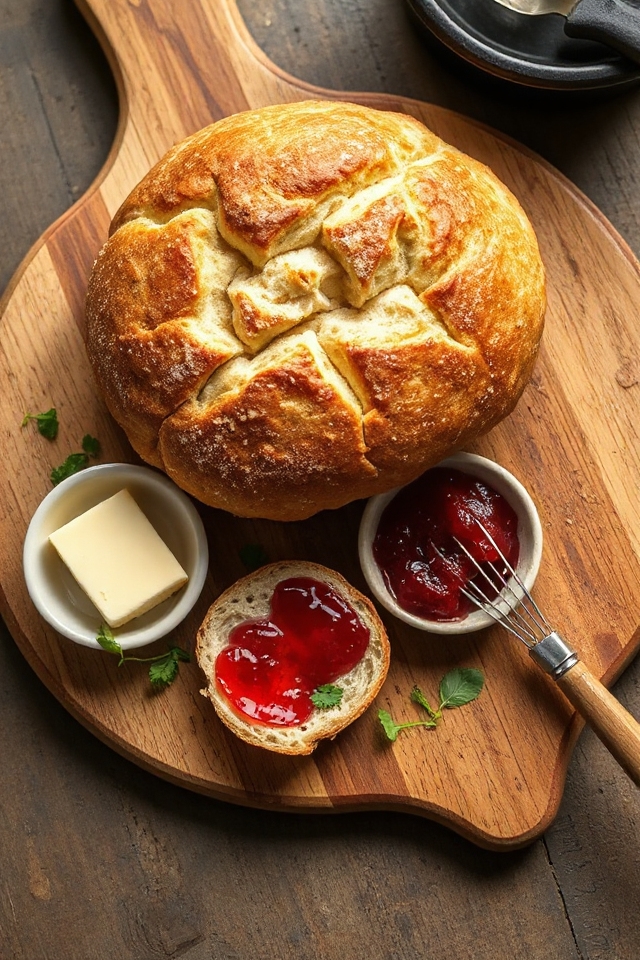Why You’ll Love This English Muffin Bread Recipe
If you’re looking for a delightful twist on traditional bread, you’ll love this English muffin bread recipe. Imagine sinking your teeth into a warm, toasty slice with those signature nooks and crannies. It’s perfect for breakfast topped with butter and jam or as a base for sandwiches. I adore how simple it’s to prepare, too! The dough comes together quickly, and you don’t need any special equipment. Plus, the aroma wafting through your kitchen while it bakes is irresistible. Trust me, once you try this recipe, you’ll wonder why you didn’t make it sooner!
Ingredients of English Muffin Bread
When it comes to baking English muffin bread, the ingredients are simple yet essential for creating that delightful texture and flavor. You won’t need any fancy or hard-to-find items – just your basic pantry staples. This recipe is all about the joy of baking, so let’s gather what we need to make this mouthwatering bread.
Here’s what you’ll need:
- 5 1/2 to 6 cups of flour
- 4 1/2 teaspoons of active dry yeast
- 1 tablespoon of sugar
- 2 teaspoons of salt
- 1/4 teaspoon of baking soda
- 2 cups of milk
- 1/2 cup of water
Now, let’s chat a bit about these ingredients. The flour is your main player here, providing structure and that chewy, satisfying texture we all love. If you’re feeling adventurous, you could even mix in some whole wheat flour for added flavor and nutrition.
The yeast is what gives the bread its rise and those lovely nooks and crannies, so make sure it’s fresh; nothing worse than waiting for dough to rise and it just sits there like a lump. Don’t forget that warm milk and water – it’s like a cozy hug for the yeast, helping it foam up nicely.
And sugar? Well, that’s just a little sweetness to help everything along. So, gather your ingredients, and let’s get ready to bake some delicious English muffin bread that will have everyone begging for seconds. Or maybe that’s just me, trying to eat the whole loaf myself.
How to Make English Muffin Bread

Alright, let’s plunge into the delightful world of making English muffin bread. It’s a simple process, but oh, the joy that comes from the aroma of freshly baked bread wafting through your kitchen is truly something special.
So, first things first: grab 2 cups of milk and 1/2 cup of water. Warm them up gently, just until they feel cozy to the touch – think of it as a warm bath for the yeast. Then, sprinkle in 4 1/2 teaspoons of active dry yeast along with 1 tablespoon of sugar and 2 teaspoons of salt.
Now, just let that sit for a few minutes until it starts to foam; this means your yeast is alive and kicking. If it doesn’t foam? Well, that’s an instant mood killer, and you might want to start over with fresh yeast.
While your yeast is getting all bubbly, grab a large mixing bowl and add 3 cups of flour together with 1/4 teaspoon of baking soda. Give it a good mix – I like to use a whisk because it’s fun, and it makes me feel like a pro.
Once your yeast mixture is ready, pour it into the flour mixture. Don’t panic if it looks a bit messy. This is where the magic happens. Gently fold in more flour until the dough is sticky but soft. You want to avoid over-mixing because that could lead to tough bread – and nobody wants that.
So, put down the whisk and switch to a spoon when you’re close to the right consistency.
Next up, let’s talk about the pans. Grease two loaf pans and sprinkle them with cornmeal. This not only prevents sticking but also adds a touch of that classic English muffin texture to the outside of the bread.
Now, scoop that lovely dough into the pans, cover them with saran wrap, and let them rise for about 45 minutes. You might find yourself pacing the kitchen, enthusiastically anticipating that first slice, or maybe that’s just me.
After the dough has risen and doubled in size, it’s time for the grand finale. Preheat your oven to 400 degrees and bake the bread for about 25 minutes. The moment they’re golden brown and you can smell that heavenly aroma, you’ll know it’s time to celebrate.
And trust me, once you slice into that soft, warm loaf, you’ll wonder why you ever settled for store-bought.
English Muffin Bread Substitutions & Variations
While English muffin bread is delicious as is, experimenting with substitutions and variations can elevate your baking experience.
I love swapping out some of the all-purpose flour for whole wheat flour for a nuttier flavor and added nutrition. You could even try adding herbs like rosemary or thyme for a savory twist.
If you’re feeling adventurous, toss in some shredded cheese or chopped olives for extra flavor. For a sweeter version, consider adding cinnamon and raisins.
Don’t hesitate to adjust the milk or water with buttermilk for a tangy touch. Each variation offers a unique spin on this classic recipe!
Additional Tips & Notes
Experimenting with substitutions and variations can lead to delightful results, but there are also some helpful tips that can enhance your English muffin bread experience.
First, make sure your liquids are warm but not hot; this helps activate the yeast effectively. I recommend using bread flour for a chewier texture, but all-purpose flour works just fine too.
When greasing your pans, cornmeal adds a nice crunch on the crust. Don’t rush the rising process—allow the dough to double in size for the best texture.
Finally, let the bread cool completely before slicing; it’ll be easier to cut! Enjoy your baking!
